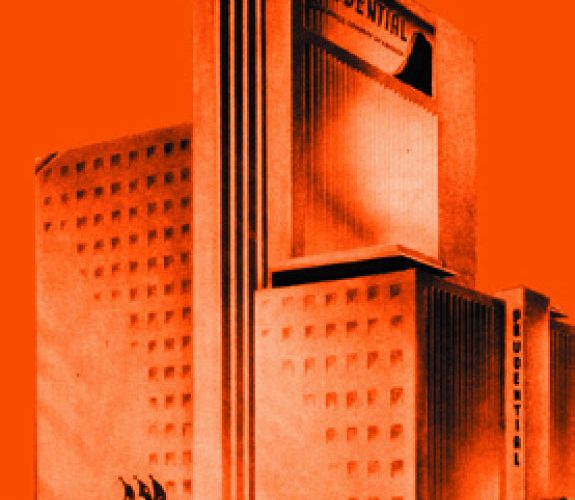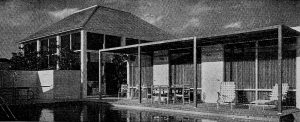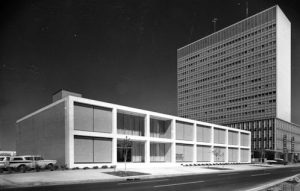
A masterwork of local 1950s modern architecture.
When it was dedicated on July 29, 1952, the Prudential Building was the second modern skyscraper to be built in Houston. Houston architect Kenneth Franzheim and his chief designer, Anton Skislewicz, imbued the building with a sense of urban style and suburban comfort that was never quite equaled in any of Franzeim`s other Houston projects. The ground level walls of the Prudential Building are clad with deep red polished Texas granite; the upper floors on the northwest and northeast sides are clad in Texas limestone. The southwest and southeast sides, though, were faced with a `unique full-height aluminum an arrangement… that will utilize solar rays and air circulation to effect economies in air conditioning.`
In front of the building`s public façade, along Holcombe Boulevard, stands a fountain without equal in Houston. The fountain consists of a simple rectangular pool with a row of bronze nautilus shells shooting jets of water at a limestone sculpture entitled Wave of Life by noted American artist Wheeler Williams, which depicts a recumbent man and woman holding aloft a child symbolizing the future. Visitors were welcomed with a wide flagstone terrace surrounded by azaleas. At the rear of the building there was an Olympic swimming pool surrounded by an elaborately patterned terrazzo deck shaded by a free-form steel and corrugated fiberglass sunscreen.
Franzheim articulated these exterior spaces with different types of paving and level changes to make the precincts around the water feel cool and secluded. This feeling was augmented by landscape architect C. C. Pat Fleming`s lush subtropical planting scheme for the 27-acre site. The pool and Fleming`s gardens are gone. The terrazzo paving from the entrance continues into the lobby, which is fitted of curved walls paneled with tropical hardwood veneers and entitled richly veined Chiaro marble revetments. Directly opposite the front doors is a mural painted in tempura on plaster by famed artist Peter Hurd entitled The Future Belongs To Those Who Prepare For It. It depicts a group of Texas farmers gathered about an oak tree with the produce of the land arrayed around them in American Scene style.
Officials of M. D. Anderson assert that they are in the business of saving lives not architecture. This is misguided. The architectural environment has a profound impact on human health and happiness. The founding trustees of the Texas Medical Center understood this. Buildings like the original M.D. Anderson Cancer Hospital of 1954, designed by Houston architects MacKie & Kamrath, with its sensitively designed interiors and handsome exterior, clearly demonstrate a concern for the impact of the environment on patient`s well-being. The Prudential Building is an architecturally intact, eminently usable component of this visionary approach, an approach that has been lost as the Texas Medical Center rushes blindly into the future. Unfortunately the Prudential Building has been demolished.


